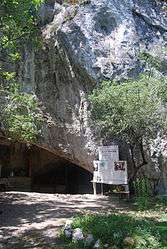Alliat
| Alliat | |
|---|---|
| Commune | |
 The entrance to the La Vache Cave | |
 Alliat Location within Occitanie region  Alliat | |
| Coordinates: 42°49′05″N 1°35′14″E / 42.8181°N 1.5872°ECoordinates: 42°49′05″N 1°35′14″E / 42.8181°N 1.5872°E | |
| Country | France |
| Region | Occitanie |
| Department | Ariège |
| Arrondissement | Foix |
| Canton | Sabarthès |
| Intercommunality | Pays de Tarascon |
| Government | |
| • Mayor (2014-2020) | Marie-Françoise Kalandadze |
| Area1 | 3.46 km2 (1.34 sq mi) |
| Population (2014)2 | 55 |
| • Density | 16/km2 (41/sq mi) |
| Time zone | UTC+1 (CET) |
| • Summer (DST) | UTC+2 (CEST) |
| INSEE/Postal code | 09006 /09400 |
| Elevation |
500–1,268 m (1,640–4,160 ft) (avg. 560 m or 1,840 ft) |
|
1 French Land Register data, which excludes lakes, ponds, glaciers > 1 km2 (0.386 sq mi or 247 acres) and river estuaries. 2 Population without double counting: residents of multiple communes (e.g., students and military personnel) only counted once. | |
Alliat is a commune in the Ariège department and Occitanie region in southwestern France.
Geography
Commune in the "Haute-Ariège" part of the Pyrenees located 15 km from the city of Foix and 5 km from the city of Tarascon-sur-Ariège, in the "Parc naturel régional des Pyrénées ariégeoises".
Population
Inhabitants of Alliat are called Alliatois.
| Historical population | ||
|---|---|---|
| Year | Pop. | ±% |
| 1806 | 96 | — |
| 1851 | 129 | +34.4% |
| 1856 | 97 | −24.8% |
| 1901 | 106 | +9.3% |
| 1921 | 81 | −23.6% |
| 1946 | 55 | −32.1% |
| 1962 | 67 | +21.8% |
| 1968 | 71 | +6.0% |
| 1975 | 68 | −4.2% |
| 1982 | 65 | −4.4% |
| 1990 | 55 | −15.4% |
| 1999 | 62 | +12.7% |
| 2008 | 64 | +3.2% |
Sights
- The "cave of the cow" (grotte de La Vache): with distinctive archeological strata discovered in its entrance and in the "salle Monique", opened to the public in 1979. It produced a remarkably rich collection of prehistorical objects from the Magdalenian era (12,000 to 14,000 years old), including a large number of harpoons and assegai points as well as more than 200 pieces of art: bones, engraved reindeer and red deer antlers, sculpture of animals, sometimes of humans, as well as rare species for that period: panther, bear, wolves, Saiga antelope, birds and salmon.
- It was one of the first caves explored in Ariège (Félix Garrigou, in 1866). A second salle was discovered in 1952 and was explored by its discoverer, Romain Robert, until 1964.
- Fortified cave Spoulgas d’Alliat: located 100 m south of the cave of the cow.[1]
Activities
- Rock climbing around the caves
- Horse ridding
See also
References
- ↑ Maps and descriptions available in "Monographies villageoises en Sabarthès", Florence Guillot, 1999.
| Wikimedia Commons has media related to Alliat. |
This article is issued from
Wikipedia.
The text is licensed under Creative Commons - Attribution - Sharealike.
Additional terms may apply for the media files.